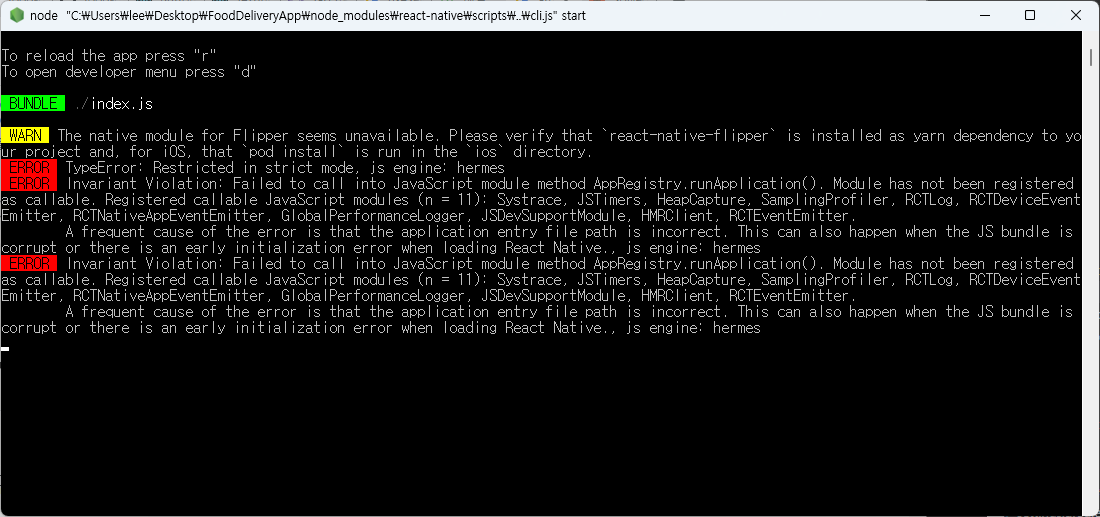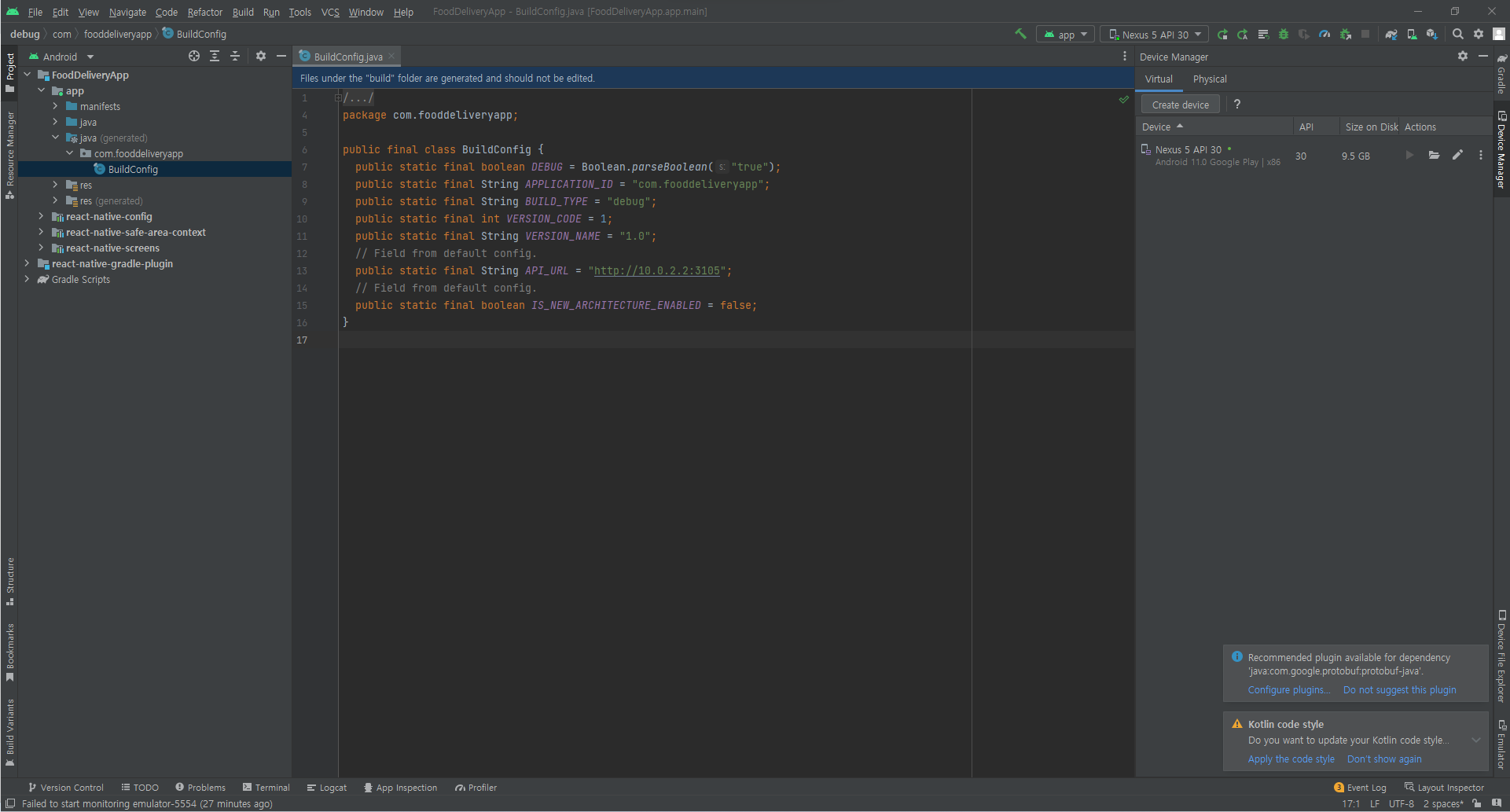-
질문 & 답변
카테고리
-
세부 분야
모바일 앱 개발
-
해결 여부
미해결
build.gradle, proguard-rules.pro 파일 수정 후 발생한 에러 로 어려움을 겪고 있습니다.
22.10.10 03:33 작성 조회수 1.22k
0
상황
안녕하세요. 제로초님! 'react-native-config 문제 해결하기' 강의 내용대로 build.gradle, proguard-rules.pro 파일을 수정하고 안드로이트 스튜디오에서 BuildConfig파일에 API_URL가 잘 뜨는 것까지 확인하고 npm run android를 입력했는데 메트로 서버에서 에러가 나타나고 emulator는 빈 화면만 보여주고 있습니다.
에러
메트로 서버 에러 내용
WARN The native module for Flipper seems unavailable. Please verify that
react-native-flipperis installed as yarn dependency to your project and, for iOS, thatpod installis run in theiosdirectory.ERROR TypeError: Restricted in strict mode, js engine: hermes
ERROR Invariant Violation: Failed to call into JavaScript module method AppRegistry.runApplication(). Module has not been registered as callable. Registered callable JavaScript modules (n = 11): Systrace, JSTimers, HeapCapture, SamplingProfiler, RCTLog, RCTDeviceEventEmitter, RCTNativeAppEventEmitter, GlobalPerformanceLogger, JSDevSupportModule, HMRClient, RCTEventEmitter. A frequent cause of the error is that the application entry file path is incorrect. This can also happen when the JS bundle is corrupt or there is an early initialization error when loading React Native., js engine: hermes
ERROR Invariant Violation: Failed to call into JavaScript module method AppRegistry.runApplication(). Module has not been registered as callable. Registered callable JavaScript modules (n = 11): Systrace, JSTimers, HeapCapture, SamplingProfiler, RCTLog, RCTDeviceEventEmitter, RCTNativeAppEventEmitter, GlobalPerformanceLogger, JSDevSupportModule, HMRClient, RCTEventEmitter. A frequent cause of the error is that the application entry file path is incorrect. This can also happen when the JS bundle is corrupt or there is an early initialization error when loading React Native., js engine: hermes

emulator

코드
android\app\build.gradle
apply plugin: "com.android.application"
apply from: project(':react-native-config').projectDir.getPath() + "/dotenv.gradle"
import com.android.build.OutputFile
import org.apache.tools.ant.taskdefs.condition.Os
/**
* The react.gradle file registers a task for each build variant (e.g. bundleDebugJsAndAssets
* and bundleReleaseJsAndAssets).
* These basically call `react-native bundle` with the correct arguments during the Android build
* cycle. By default, bundleDebugJsAndAssets is skipped, as in debug/dev mode we prefer to load the
* bundle directly from the development server. Below you can see all the possible configurations
* and their defaults. If you decide to add a configuration block, make sure to add it before the
* `apply from: "../../node_modules/react-native/react.gradle"` line.
*
* project.ext.react = [
* // the name of the generated asset file containing your JS bundle
* bundleAssetName: "index.android.bundle",
*
* // the entry file for bundle generation. If none specified and
* // "index.android.js" exists, it will be used. Otherwise "index.js" is
* // default. Can be overridden with ENTRY_FILE environment variable.
* entryFile: "index.android.js",
*
* // https://reactnative.dev/docs/performance#enable-the-ram-format
* bundleCommand: "ram-bundle",
*
* // whether to bundle JS and assets in debug mode
* bundleInDebug: false,
*
* // whether to bundle JS and assets in release mode
* bundleInRelease: true,
*
* // whether to bundle JS and assets in another build variant (if configured).
* // See http://tools.android.com/tech-docs/new-build-system/user-guide#TOC-Build-Variants
* // The configuration property can be in the following formats
* // 'bundleIn${productFlavor}${buildType}'
* // 'bundleIn${buildType}'
* // bundleInFreeDebug: true,
* // bundleInPaidRelease: true,
* // bundleInBeta: true,
*
* // whether to disable dev mode in custom build variants (by default only disabled in release)
* // for example: to disable dev mode in the staging build type (if configured)
* devDisabledInStaging: true,
* // The configuration property can be in the following formats
* // 'devDisabledIn${productFlavor}${buildType}'
* // 'devDisabledIn${buildType}'
*
* // the root of your project, i.e. where "package.json" lives
* root: "../../",
*
* // where to put the JS bundle asset in debug mode
* jsBundleDirDebug: "$buildDir/intermediates/assets/debug",
*
* // where to put the JS bundle asset in release mode
* jsBundleDirRelease: "$buildDir/intermediates/assets/release",
*
* // where to put drawable resources / React Native assets, e.g. the ones you use via
* // require('./image.png')), in debug mode
* resourcesDirDebug: "$buildDir/intermediates/res/merged/debug",
*
* // where to put drawable resources / React Native assets, e.g. the ones you use via
* // require('./image.png')), in release mode
* resourcesDirRelease: "$buildDir/intermediates/res/merged/release",
*
* // by default the gradle tasks are skipped if none of the JS files or assets change; this means
* // that we don't look at files in android/ or ios/ to determine whether the tasks are up to
* // date; if you have any other folders that you want to ignore for performance reasons (gradle
* // indexes the entire tree), add them here. Alternatively, if you have JS files in android/
* // for example, you might want to remove it from here.
* inputExcludes: ["android/**", "ios/**"],
*
* // override which node gets called and with what additional arguments
* nodeExecutableAndArgs: ["node"],
*
* // supply additional arguments to the packager
* extraPackagerArgs: []
* ]
*/
project.ext.react = [
enableHermes: true, // clean and rebuild if changing
]
apply from: "../../node_modules/react-native/react.gradle"
/**
* Set this to true to create two separate APKs instead of one:
* - An APK that only works on ARM devices
* - An APK that only works on x86 devices
* The advantage is the size of the APK is reduced by about 4MB.
* Upload all the APKs to the Play Store and people will download
* the correct one based on the CPU architecture of their device.
*/
def enableSeparateBuildPerCPUArchitecture = false
/**
* Run Proguard to shrink the Java bytecode in release builds.
*/
def enableProguardInReleaseBuilds = false
/**
* The preferred build flavor of JavaScriptCore.
*
* For example, to use the international variant, you can use:
* `def jscFlavor = 'org.webkit:android-jsc-intl:+'`
*
* The international variant includes ICU i18n library and necessary data
* allowing to use e.g. `Date.toLocaleString` and `String.localeCompare` that
* give correct results when using with locales other than en-US. Note that
* this variant is about 6MiB larger per architecture than default.
*/
def jscFlavor = 'org.webkit:android-jsc:+'
/**
* Whether to enable the Hermes VM.
*
* This should be set on project.ext.react and that value will be read here. If it is not set
* on project.ext.react, JavaScript will not be compiled to Hermes Bytecode
* and the benefits of using Hermes will therefore be sharply reduced.
*/
def enableHermes = project.ext.react.get("enableHermes", false);
/**
* Architectures to build native code for.
*/
def reactNativeArchitectures() {
def value = project.getProperties().get("reactNativeArchitectures")
return value ? value.split(",") : ["armeabi-v7a", "x86", "x86_64", "arm64-v8a"]
}
android {
ndkVersion rootProject.ext.ndkVersion
compileSdkVersion rootProject.ext.compileSdkVersion
defaultConfig {
applicationId "com.fooddeliveryapp"
minSdkVersion rootProject.ext.minSdkVersion
targetSdkVersion rootProject.ext.targetSdkVersion
versionCode 1
versionName "1.0"
buildConfigField "boolean", "IS_NEW_ARCHITECTURE_ENABLED", isNewArchitectureEnabled().toString()
resValue "string", "build_config_package", "com.fooddeliveryapp"
if (isNewArchitectureEnabled()) {
// We configure the CMake build only if you decide to opt-in for the New Architecture.
externalNativeBuild {
cmake {
arguments "-DPROJECT_BUILD_DIR=$buildDir",
"-DREACT_ANDROID_DIR=$rootDir/../node_modules/react-native/ReactAndroid",
"-DREACT_ANDROID_BUILD_DIR=$rootDir/../node_modules/react-native/ReactAndroid/build",
"-DNODE_MODULES_DIR=$rootDir/../node_modules",
"-DANDROID_STL=c++_shared"
}
}
if (!enableSeparateBuildPerCPUArchitecture) {
ndk {
abiFilters (*reactNativeArchitectures())
}
}
}
}
if (isNewArchitectureEnabled()) {
// We configure the NDK build only if you decide to opt-in for the New Architecture.
externalNativeBuild {
cmake {
path "$projectDir/src/main/jni/CMakeLists.txt"
}
}
def reactAndroidProjectDir = project(':ReactAndroid').projectDir
def packageReactNdkDebugLibs = tasks.register("packageReactNdkDebugLibs", Copy) {
dependsOn(":ReactAndroid:packageReactNdkDebugLibsForBuck")
from("$reactAndroidProjectDir/src/main/jni/prebuilt/lib")
into("$buildDir/react-ndk/exported")
}
def packageReactNdkReleaseLibs = tasks.register("packageReactNdkReleaseLibs", Copy) {
dependsOn(":ReactAndroid:packageReactNdkReleaseLibsForBuck")
from("$reactAndroidProjectDir/src/main/jni/prebuilt/lib")
into("$buildDir/react-ndk/exported")
}
afterEvaluate {
// If you wish to add a custom TurboModule or component locally,
// you should uncomment this line.
// preBuild.dependsOn("generateCodegenArtifactsFromSchema")
preDebugBuild.dependsOn(packageReactNdkDebugLibs)
preReleaseBuild.dependsOn(packageReactNdkReleaseLibs)
// Due to a bug inside AGP, we have to explicitly set a dependency
// between configureCMakeDebug* tasks and the preBuild tasks.
// This can be removed once this is solved: https://issuetracker.google.com/issues/207403732
configureCMakeRelWithDebInfo.dependsOn(preReleaseBuild)
configureCMakeDebug.dependsOn(preDebugBuild)
reactNativeArchitectures().each { architecture ->
tasks.findByName("configureCMakeDebug[${architecture}]")?.configure {
dependsOn("preDebugBuild")
}
tasks.findByName("configureCMakeRelWithDebInfo[${architecture}]")?.configure {
dependsOn("preReleaseBuild")
}
}
}
}
splits {
abi {
reset()
enable enableSeparateBuildPerCPUArchitecture
universalApk false // If true, also generate a universal APK
include (*reactNativeArchitectures())
}
}
signingConfigs {
debug {
storeFile file('debug.keystore')
storePassword 'android'
keyAlias 'androiddebugkey'
keyPassword 'android'
}
}
buildTypes {
debug {
signingConfig signingConfigs.debug
}
release {
// Caution! In production, you need to generate your own keystore file.
// see https://reactnative.dev/docs/signed-apk-android.
signingConfig signingConfigs.debug
minifyEnabled enableProguardInReleaseBuilds
proguardFiles getDefaultProguardFile("proguard-android.txt"), "proguard-rules.pro"
}
}
// applicationVariants are e.g. debug, release
applicationVariants.all { variant ->
variant.outputs.each { output ->
// For each separate APK per architecture, set a unique version code as described here:
// https://developer.android.com/studio/build/configure-apk-splits.html
// Example: versionCode 1 will generate 1001 for armeabi-v7a, 1002 for x86, etc.
def versionCodes = ["armeabi-v7a": 1, "x86": 2, "arm64-v8a": 3, "x86_64": 4]
def abi = output.getFilter(OutputFile.ABI)
if (abi != null) { // null for the universal-debug, universal-release variants
output.versionCodeOverride =
defaultConfig.versionCode * 1000 + versionCodes.get(abi)
}
}
}
}
dependencies {
implementation fileTree(dir: "libs", include: ["*.jar"])
//noinspection GradleDynamicVersion
implementation "com.facebook.react:react-native:+" // From node_modules
implementation "androidx.swiperefreshlayout:swiperefreshlayout:1.0.0"
debugImplementation("com.facebook.flipper:flipper:${FLIPPER_VERSION}") {
exclude group:'com.facebook.fbjni'
}
debugImplementation("com.facebook.flipper:flipper-network-plugin:${FLIPPER_VERSION}") {
exclude group:'com.facebook.flipper'
exclude group:'com.squareup.okhttp3', module:'okhttp'
}
debugImplementation("com.facebook.flipper:flipper-fresco-plugin:${FLIPPER_VERSION}") {
exclude group:'com.facebook.flipper'
}
if (enableHermes) {
//noinspection GradleDynamicVersion
implementation("com.facebook.react:hermes-engine:+") { // From node_modules
exclude group:'com.facebook.fbjni'
}
} else {
implementation jscFlavor
}
}
if (isNewArchitectureEnabled()) {
// If new architecture is enabled, we let you build RN from source
// Otherwise we fallback to a prebuilt .aar bundled in the NPM package.
// This will be applied to all the imported transtitive dependency.
configurations.all {
resolutionStrategy.dependencySubstitution {
substitute(module("com.facebook.react:react-native"))
.using(project(":ReactAndroid"))
.because("On New Architecture we're building React Native from source")
substitute(module("com.facebook.react:hermes-engine"))
.using(project(":ReactAndroid:hermes-engine"))
.because("On New Architecture we're building Hermes from source")
}
}
}
// Run this once to be able to run the application with BUCK
// puts all compile dependencies into folder libs for BUCK to use
task copyDownloadableDepsToLibs(type: Copy) {
from configurations.implementation
into 'libs'
}
apply from: file("../../node_modules/@react-native-community/cli-platform-android/native_modules.gradle"); applyNativeModulesAppBuildGradle(project)
def isNewArchitectureEnabled() {
// To opt-in for the New Architecture, you can either:
// - Set `newArchEnabled` to true inside the `gradle.properties` file
// - Invoke gradle with `-newArchEnabled=true`
// - Set an environment variable `ORG_GRADLE_PROJECT_newArchEnabled=true`
return project.hasProperty("newArchEnabled") && project.newArchEnabled == "true"
}
android\app\proguard-rules.pro
# Add project specific ProGuard rules here.
# By default, the flags in this file are appended to flags specified
# in /usr/local/Cellar/android-sdk/24.3.3/tools/proguard/proguard-android.txt
# You can edit the include path and order by changing the proguardFiles
# directive in build.gradle.
#
# For more details, see
# http://developer.android.com/guide/developing/tools/proguard.html
# Add any project specific keep options here:
-keep class com.fooddeliveryapp.BuildConfig { *; }
Android Studio (BuildConfig에 public static final String API_URL 생성됨)

src/pages/SignUp.tsx
import React, {useCallback, useRef, useState} from 'react';
import {
ActivityIndicator,
Alert,
Platform,
Pressable,
StyleSheet,
Text,
TextInput,
View,
} from 'react-native';
import {NativeStackScreenProps} from '@react-navigation/native-stack';
import {RootStackParamList} from '../../AppInner';
import DismissKeyboardView from '../components/DissmissKeyboardView';
import axios, {AxiosError} from 'axios';
import Config from 'react-native-config';
type SignUpScreenProps = NativeStackScreenProps<RootStackParamList, 'SignUp'>;
function SignUp({navigation}: SignUpScreenProps) {
const [loading, setLoading] = useState(false);
const [email, setEmail] = useState('');
const [name, setName] = useState('');
const [password, setPassword] = useState('');
const emailRef = useRef<TextInput | null>(null);
const nameRef = useRef<TextInput | null>(null);
const passwordRef = useRef<TextInput | null>(null);
const onChangeEmail = useCallback(text => {
setEmail(text.trim()); // 스페이스바 입력못하게 미리 방지
}, []);
const onChangeName = useCallback(text => {
setName(text.trim());
}, []);
const onChangePassword = useCallback(text => {
setPassword(text.trim());
}, []);
const onSubmit = useCallback(async () => {
// 로딩 중일 때 회원가입 버튼 또 누르면 return해서 막기
if (loading) {
return;
}
if (!email || !email.trim()) {
return Alert.alert('알림', '이메일을 입력해주세요.');
}
if (!name || !name.trim()) {
return Alert.alert('알림', '이름을 입력해주세요.');
}
if (!password || !password.trim()) {
return Alert.alert('알림', '비밀번호를 입력해주세요.');
}
if (
!/^(([^<>()\[\]\.,;:\s@\"]+(\.[^<>()\[\]\.,;:\s@\"]+)*)|(\".+\"))@(([^<>()[\]\.,;:\s@\"]+\.)+[^<>()[\]\.,;:\s@\"]{2,})$/.test(
email,
)
) {
return Alert.alert('알림', '올바른 이메일 주소가 아닙니다.');
}
if (!/^(?=.*[A-Za-z])(?=.*[0-9])(?=.*[$@^!%*#?&]).{8,50}$/.test(password)) {
return Alert.alert(
'알림',
'비밀번호는 영문,숫자,특수문자($@^!%*#?&)를 모두 포함하여 8자 이상 입력해야합니다.',
);
}
console.log(email, name, password);
// 서버에 요청하기
try {
// 로딩 상태
setLoading(true);
console.log(Config.API_URL);
const response = await axios.post(`${Config.API_URL}/user`, {
email,
name,
password,
});
console.log(response);
Alert.alert('알림', '회원가입되었습니다');
} catch (error) {
// 네트워크 에러 타입 지정
// const errorResponse = (error as AxiosError).response;
console.error(error);
// if (errorResponse) {
// Alert.alert('알림', errorResponse.data.message);
// }
} finally {
// 성공하든 실패하든 로딩 상태 변경
setLoading(false);
}
Alert.alert('알림', '회원가입 되었습니다.');
}, [email, name, password]);
const canGoNext = email && name && password;
return (
<DismissKeyboardView>
<View style={styles.inputWrapper}>
<Text style={styles.label}>이메일</Text>
<TextInput
style={styles.textInput}
onChangeText={onChangeEmail}
placeholder="이메일을 입력해주세요"
placeholderTextColor="#666"
textContentType="emailAddress"
value={email}
returnKeyType="next"
clearButtonMode="while-editing"
keyboardType="email-address"
ref={emailRef}
onSubmitEditing={() => nameRef.current?.focus()}
blurOnSubmit={false}
/>
</View>
<View style={styles.inputWrapper}>
<Text style={styles.label}>이름</Text>
<TextInput
style={styles.textInput}
placeholder="이름을 입력해주세요."
placeholderTextColor="#666"
onChangeText={onChangeName}
value={name}
textContentType="name"
returnKeyType="next"
clearButtonMode="while-editing"
ref={nameRef}
onSubmitEditing={() => passwordRef.current?.focus()}
blurOnSubmit={false}
/>
</View>
<View style={styles.inputWrapper}>
<Text style={styles.label}>비밀번호</Text>
<TextInput
style={styles.textInput}
placeholder="비밀번호를 입력해주세요(영문,숫자,특수문자)"
placeholderTextColor="#666"
onChangeText={onChangePassword}
value={password}
keyboardType={Platform.OS === 'android' ? 'default' : 'ascii-capable'}
textContentType="password"
secureTextEntry
returnKeyType="send"
clearButtonMode="while-editing"
ref={passwordRef}
onSubmitEditing={onSubmit}
/>
</View>
<View style={styles.buttonZone}>
<Pressable
style={
canGoNext
? StyleSheet.compose(styles.loginButton, styles.loginButtonActive)
: styles.loginButton
}
// 로딩 중일 때는 회원가입 버튼 클릭못하게 막기
disabled={!canGoNext || loading}
onPress={onSubmit}>
{/* 로딩 중일 때, indicator 보여주기 */}
{loading ? (
<ActivityIndicator color="white" />
) : (
<Text style={styles.loginButtonText}>회원가입</Text>
)}
</Pressable>
</View>
</DismissKeyboardView>
);
}
const styles = StyleSheet.create({
textInput: {
padding: 5,
borderBottomWidth: StyleSheet.hairlineWidth,
},
inputWrapper: {
padding: 20,
},
label: {
fontWeight: 'bold',
fontSize: 16,
marginBottom: 20,
},
buttonZone: {
alignItems: 'center',
},
loginButton: {
backgroundColor: 'gray',
paddingHorizontal: 20,
paddingVertical: 10,
borderRadius: 5,
marginBottom: 10,
},
loginButtonActive: {
backgroundColor: 'blue',
},
loginButtonText: {
color: 'white',
fontSize: 16,
},
});
export default SignUp;
.env
API_URL=http://10.0.2.2:3105
에러 해결을 위해 시도해본 것
emulator 삭제 및 새로 생성 - 효과 x
build.gradle, proguard-rules.pro 파일의 내용 원상복귀 - 효과 x
에러 내용 중 일부(
Invariant Violation: Failed to call into JavaScript module method AppRegistry.runApplication()) 구글링하여 얻은 정보로npm start --reset-cache입력 - 효과 xvscode 포함 모든 프로그램 종료 후 재실행 - 효과 x
어떻게 해결해야할지 모르겠습니다..!
답변을 작성해보세요.




답변 1